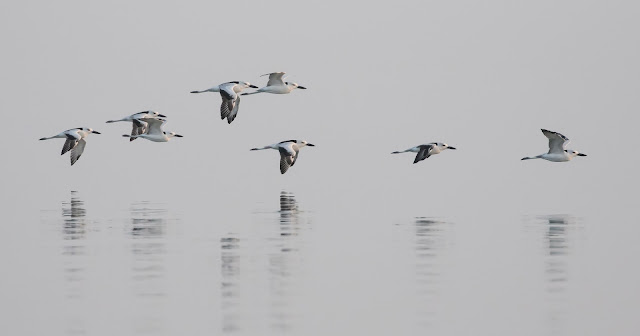We leave Muscat, pass through the Al Hajar mountains and entered the desert:
Four and a half hours later with only two species of bird seen (Hoopoe Lark and Brown-necked Raven) we arrived at the coast of central-eastern Oman, the winter home to millions of shorebirds. Having seen Sooty Falcon in the morning, our efforts are now concentrated on seeing our other major target, Crab Plover. These unique waders can be found in the huge wader flocks that winter on the coast of Barr Al Hickman, but it seems most reliable on the mudflats of Masirah Island. To get there we planned to get arrive at Barr Al Hickman with a little time to search through some wader flocks on the mainland, before boarding the 6pm ferry to Masirah:
Bar-tailed Godwits were abundant. We scanned through flocks of these birds for their much rarer congener, Great Knot, but without success:
The wintering Oystercatchers were distinctive, presumably of the eastern longipes subspecies:
A typical quiet patch on high tide shoreline: Terek Sandpipers and Little Stint at the front, Spotted Redshanks in the middle-ground and Bar-tailed Godwit and Oystercatchers at the back:
Curlew Sandpipers, Little Stints, Greater and Lesser Sandplovers, Grey Plovers, Bar-tailed Godwits:
Drier areas just inland held large mixed flocks of Sandplovers and Curlew Sandpipers:
We spent a night in a hotel which we never saw in daylight, then drove the 21km south to Sur Masirah, negotiating a track through a ram-shackled coastal village to arrive on the mudflats before dawn. Richard was anxious. He had sworn he would not leave Oman until he had seen Crab Plover, on our tight schedule this morning was our one opportunity to fulfill that dream. Having seen the sheer numbers of waders that winter on the coast here would we have time to find a Crab Plover among the millions of other shorebirds? As the sun rose we could make out large flocks of waders on the shoreline:
It was just light enough to begin searching. I picked up my binoculars and scanned through the nearest birds. I relaxed. "Crab Plover. All of them!"
And indeed they were:
These are quite remarkable waders. The huge black bill, the pied appearance, those long legs and the peculiar horizontal gait contribute to an unmistakable charismatic combination. Most bizarrely, they nest in burrows, the digging of which must be helped by that enormous black bill:
Click the settings cog at watch at 720p.
We spent about an hour with these fantastic creatures, before heading back to Masirah town. Masirah island was a strange place, a sandy outpost on the edge of the Indian Ocean. Camels were common here, in the sand between the coast and the central hills. Heading east of Masirah Island the next land is the Indian subcontinent on the other side of the Indian Ocean.
We checked the coast before catching our ferry back to the mainland.
Lesser Sand Plover:
Sooty Gull, the abundant Gull of the Omani coast. Great bill colours!
We caught the 8am ferry back to Shannon, but not before I fell in love with the young lady on the ticket counter at the ferry terminal. True, I could only see her wrists and eyes as she was wearing full hijab and burka. But that was enough. "Ticket" she said, her voice a sweet river of dark chocolate, before she made full eye-contact. I plunged into the dark pools of her eyes, knowing I was lost and at her mercy. "Mmmmhhhh" I mumbled. She looked at my ticket and said the words that broke my heart: "Next". We parted, never to meet again. Outside in the car Richard asked, "how was that?". "Intense" I replied. We boarded the ferry.
Below, the Shannah-Masirah ferry. We now knew to locate the Men's lounge and think we returned without causing great offence.
The viewing deck for the journey back to the mainland. Spot the European traveler:
We spent the entire one hour journey on deck. Wilson's Petrel were quite common away from the coasts, we came across a total of 25 in the central part of the journey back, together with Sooty and Heuglin's Gulls; Swift, Sandwhich and Little Terns. Arriving back at Barr Al Hickman we had a short while to explore the coast here. Barr Al Hickman is a vast flat area of sand, water and salt. Driving here, away from the roads, can be treacherous. Some areas were completely barren:
We headed south to the village of Filim, a traditional spot to view the wader flocks. In one scan from here I think I saw more shorebirds than I have ever seen from one single vantage point before. Out in the distance, behind the Flamingos in the foreground, are thousands upon thousands of waders:
The further back one looked, the more there were:
Unfortunately the light was against us and so was the time. We continued our journey south and drove inland into the desert...





























No comments:
Post a Comment